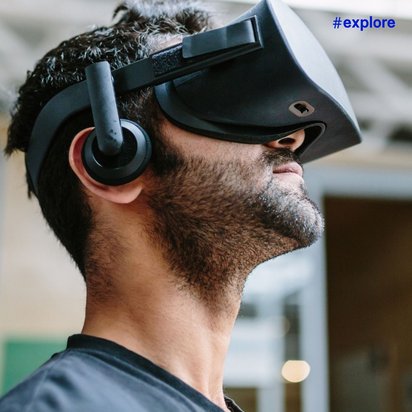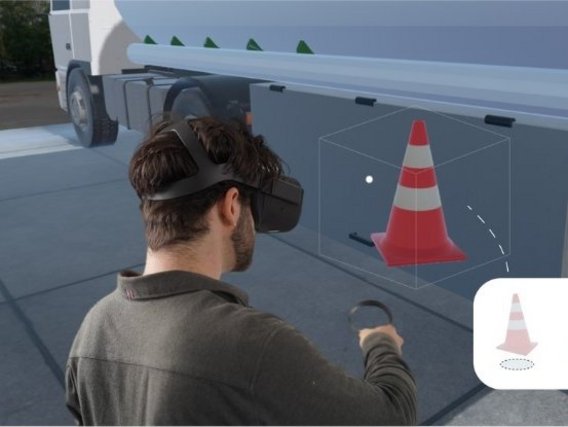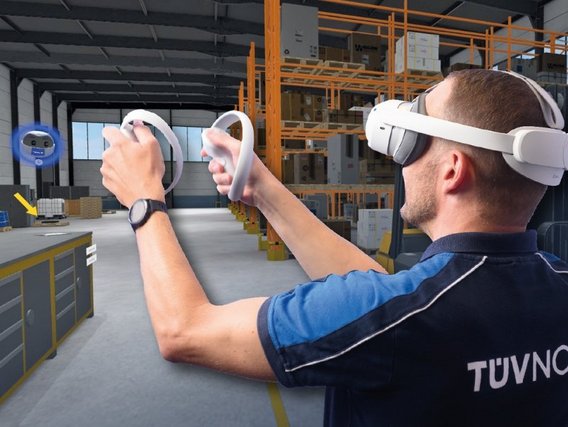Virtual Reality
Learning Safely for Emergency Situations.
How Virtual Reality is Changing Further Education.

Virtual Reality
How Virtual Reality is Changing Further Education.

21 October 2024
Those who want to continue their education often spend their time in seminar rooms or in front of a screen. Practical experience is often lacking: emergency situations cannot be easily simulated, the necessary machines are not always available, or they are simply too dangerous for inexperienced users. TÜV NORD Akademie wants to change this—with the Virtual Reality training programs of the start-up 3spin Learning.
On the loading platform of the delivery van, a final check of the toolbox—then it's into the elevator and up to the nacelle of the wind turbine. The control systems need to be inspected: Are the sensors working correctly? Check. The wind is expected to come from the west at three to five meters per second today? Check. The power supply is verified, and then the test sequence is activated.
Suddenly, the nacelle shakes. An earthquake. Fallen steel beams have blocked the hatch leading downward—only the hatch above remains. But its hinge is jammed. A couple of hammer strikes, and the hatch is open. Climbing up the ladder onto the roof of the nacelle.
The rescue helicopter is already hovering above the turbine. But as long as the blades are still turning, it cannot get any closer. Back into the nacelle to shut down the system. Then back up again—rescued! Below, yellow rapeseed fields pass by beneath the helicopter. And when you push up the virtual reality headset, you find yourself back in the seminar room of the TÜV NORD Akademie in Berlin-Mitte.
The key term is experiential or immersive learning, explains Thomas Hoger, co-founder of the virtual reality platform 3spin Learning, in which the TÜV NORD Group invested at the beginning of 2024. “Immersive learning is a learning method that uses modern technologies – in our case, virtual reality, augmented reality, and mixed reality – to create an engaging learning experience.” Participants learn as if they were on-site and could actively take part. After all, an emergency situation in a wind turbine cannot simply be simulated in real life.

Since this virtual visit to the machine house is primarily meant to demonstrate the basic feasibility of such an inspection mission, it does not yet cover all the scenarios that could be relevant in such a situation. This is different from the VR training for treating stroke patients, which 3spin Learning developed for the pharmaceutical company Pfizer in 2023. In these emergencies, every second and every action counts. However, aspiring doctors usually have to simulate them in storage rooms or hospital basements. In 3spin Learning’s VR training, medical professionals can now practice interacting with colleagues and virtual patients in an emergency room and a CT room. “With AI integration, these virtual patients can even react differently each time to everything I say,” explains Hoger.
While the learning environments cannot compete with the lifelike realism of modern video games, they are not meant to. In an evacuation training, for example, the focus is on process flow, reaction speed, and the emotional response of participants, says Hoger. Details such as a physically accurate functioning door are not necessarily relevant for this purpose.
However, the functional graphics offer another advantage: VR training is by no means a new concept. Until now, it was primarily large companies like Audi or Deutsche Bahn that could afford it, using VR to train their staff, for instance, in handling wheelchair lifts on ICE trains. But Virtual Reality for only a few was not enough for Hoger and his colleagues. To make the technology's benefits affordable for many, they developed their "No Code" platform – a virtual, cloud-based toolkit that allows companies to create their own training sessions. Trainees at E.ON, for example, are already designing various learning scenarios through the platform without needing any programming knowledge.
The TÜV NORD Academy will gradually expand its training courses with VR modules in collaboration with 3spin Learning. For example, the training for hazardous goods officers: "To practice whether the respective hazardous goods are marked with the correct labels, whether they are properly sealed and stored, you don't want to handle these dangerous substances directly," explains Melanie Vogt from the TÜV NORD Academy. First aid for electrical accidents and working with high voltage in general will also be practiced safely in virtual reality in the future. A VR training program is also planned for the continuing education of boiler operators. "Participants will be able to test the theoretical knowledge they have acquired on a virtual steam boiler at an industrial scale," reports Vogt.

In addition to simulating massive industrial plants, interpersonal situations can also be recreated in virtual reality. Sensitive conversations with employees, for example, are typically reenacted in role-playing exercises with other participants in leadership training. In these scenarios, two more or less willing volunteers sit in the center, while the others can only watch and later give their assessments. "In my experience, such role-plays are often unrealistic and, for everyone involved, more uncomfortable than insightful," says Melanie Vogt. In virtual reality, however, handling such sensitive to critical conversation situations can be practiced without distractions and without being observed— and as long as necessary.
To make these conversation scenarios as lifelike as possible, 3spin Learning works with artificial intelligence. "The AI adjusts completely to the learner's knowledge and responses," explains Thomas Hoger.
The AI colleagues surprise their human counterpart with different behaviors, so that the learners are no longer caught off guard by such behavior in real-life situations. In these interactive dialogues, the AI could also speak in different voices, languages, dialects, or even in youth slang, adds Hoger: "This is truly a revolutionary way of learning, which is already possible and will, of course, develop significantly in the near future."
This is an article from #explore. #explore is a digital journey of discovery into a world that is rapidly changing. Increasing connectivity, innovative technologies, and all-encompassing digitalization are creating new things and turning the familiar upside down. However, this also brings dangers and risks: #explore shows a safe path through the connected world.